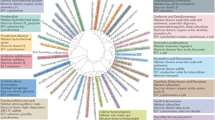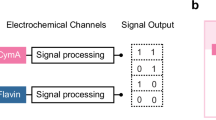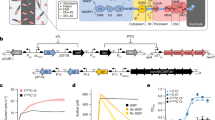Abstract
Bio-electrochemical systems (BESs) have recently emerged as an exciting technology. In a BES, bacteria interact with electrodes using electrons, which are either removed or supplied through an electrical circuit. The most-described type of BES is microbial fuel cells (MFCs), in which useful power is generated from electron donors as, for example, present in wastewater. This form of charge transport, known as extracellular electron transfer, was previously extensively described with respect to metals such as iron and manganese. The importance of these interactions in global biogeochemical cycles is essentially undisputed. A wide variety of bacteria can participate in extracellular electron transfer, and this phenomenon is far more widespread than previously thought. The use of BESs in diverse research projects is helping elucidate the mechanism by which bacteria shuttle electrons externally. New forms of interactions between bacteria have been discovered demonstrating how multiple populations within microbial communities can co-operate to achieve energy generation. New environmental processes that were difficult to observe or study previously can now be simulated and improved via BESs. Whereas pure culture studies make up the majority of the studies performed thus far, even greater contributions of BESs are expected to occur in natural environments and with mixed microbial communities. Owing to their versatility, unmatched level of control and capacity to sustain novel processes, BESs might well serve as the foundation of a new environmental biotechnology. While highlighting some of the major breakthroughs and addressing only recently obtained data, this review points out that despite rapid progress, many questions remain unanswered.
Similar content being viewed by others
Log in or create a free account to read this content
Gain free access to this article, as well as selected content from this journal and more on nature.com
or
References
Aelterman P, Rabaey K, The Pham H, Boon N, Verstraete W . (2006). Continuous electricity generation at high voltages and currents using stacked microbial fuel cells. Environ Sci Technol 40: 3388–3394.
Afkar E, Reguera G, Schiffer M, Lovley DR . (2005). A novel Geobacteraceae-specific outer membrane protein J (OmpJ) is essential for electron transport to Fe (III) and Mn (IV) oxides in Geobacter sulfurreducens. BMC Microbiology 5: Art. No. 41.
Bard AJ, Faulkner LR . (2001). Electrochemical Methods: Fundamentals and Applications, 2nd edn. John Wiley & Sons: New York.
Bergel A, Feron D, Mollica A . (2005). Catalysis of oxygen reduction in PEM fuel cell by seawater biofilm. Electrochem Comm 7: 900–904.
Bond DR, Lovley DR . (2003). Electricity production by Geobacter sulfurreducens attached to electrodes. Appl Environ Microbiol 69: 1548–1555.
Bond DR, Lovley DR . (2005). Evidence for involvement of an electron shuttle in electricity generation by geothrix fermentans. Appl Environ Microbiol 71: 2186–2189.
Childers SE, Ciufo S, Lovley DR . (2002). Geobacter metallireducens accesses insoluble Fe(III) oxide by chemotaxis. Nature 416: 767–769.
Clauwaert P, Rabaey K, Aelterman P, De Schamphelaire L, The Pham H, Boeckx P et al. (2007). Biological denitrification driven by microbial fuel cells. Environ Sci Technol (available online).
Finkelstein DA, Tender LM, Zeikus JG . (2006). Effect of electrode potential on electrode-reducing microbiota. Environ Sci Technol 40: 6990–6995.
Freguia S, Yuan S, Rabaey K, Keller J . (2007). Electron and carbon balances in microbial fuel cells reveal temporary bacterial storage behaviour during electricity generation. Environ Sci Technol (available online).
Gorby YA, Yanina S, McLean JS, Rosso KM, Moyles D, Dohnalkova A et al. (2006). Electrically conductive bacterial nanowires produced by Shewanella oneidensis strain MR-1 and other microorganisms. Proc Natl Acad Sci USA 103: 11358–11363.
Gregory KB, Bond DR, Lovley DR . (2004). Graphite electrodes as electron donors for anaerobic respiration. Environ Microbiol 6: 596–604.
Gregory KB, Lovley DR . (2005). Remediation and recovery of uranium from contaminated subsurface environments with electrodes. Environ Sci Technol 39: 8943–8947.
He Z, Angenent LT . (2006). Application of bacterial biocathodes in microbial fuel cells. Electroanalysis 18: 2009–2015.
Heijnen JJ . (1999). Bioenergetics of microbial growth. In: Flickinger MC, Drew SW (eds). Bioprocess Technology: Fermentation, Biocatalysis and Bioseparation. John Wiley & Sons Inc.: New York, pp 267–291.
Hernandez ME, Kappler A, Newman DK . (2004). Phenazines and other redox-active antibiotics promote microbial mineral reduction. Appl Environ Microbiol 70: 921–928.
Holmes DE, Chaudhuri SK, Nevin KP, Mehta T, Methe BA, Liu A et al. (2006). Microarray and genetic analysis of electron transfer to electrodes in Geobacter sulfurreducens. Environ Microbiol 8: 1805–1815.
Kostka JE, Stucki JW, Nealson KH, Wu J . (1996). Reduction of structural Fe(III) in smectite by a pure culture of Shewanella putrefaciens strain MR-1. Clays Clay Min 44: 522–529.
Kostka JE, Wu J, Nealson KH, Stucki JW . (1999). The impact of structural Fe(III) reduction by bacteria on the surface chemistry of smectite clay minerals. Geochim Geochos Acta 63: 3705–3713.
Larminie J, Dicks A . (2000). Fuel Cell Systems Explained. John Wiley & Sons: Chichester, 308pp.
Leang C, Adams LA, Chin KJ, Nevin KP, Methe BA, Webster J et al. (2005). Adaptation to disruption of the electron transfer pathway for Fe(III) reduction in Geobacter sulfurreducens. J Bacteriol 187: 5918–5926.
Liu H, Grot S, Logan BE . (2005). Electrochemically assisted microbial production of hydrogen from acetate. Environ Sci Technol 39: 4317–4320.
Logan B, Aelterman P, Hamelers B, Rozendal R, Schroder U, Keller J et al. (2006). Microbial fuel cells: methodology and technology. Environ Sci Technol 40: 5181–5192.
Lovley DR . (2000). Fe(III) and Mn(IV)-reducing prokaryotes. In: Dworkin M, Falkow S, Rosenberg E, Schleifer K, Stackebrandt E (eds). The Prokaryotes. Springer-Verlag: New York.
Lovley DR . (2006). Bug juice: harvesting electricity with microorganisms. Nat Rev Microbiol 4: 497–508.
Lovley DR, Coates JD, BluntHarris EL, Phillips EJP, Woodward JC . (1996). Humic substances as electron acceptors for microbial respiration. Nature 382: 445–448.
Lovley DR, Holmes DE, Nevin KP . (2004). Dissimilatory Fe(III) and Mn(IV) reduction. Adv Microb Physiol 49: 219–286.
Lovley DR, Stolz JF, Nord GL, Phillips EJP . (1987). Anaerobic production of magnetite by a dissimilatory iron-reducing microorganism. Nature 330: 252–254.
MacGillivray AD . (1968). Nernst-Planck equations and the electroneutrality and Donnan equilibrium assumptions. J Chem Phys 48: 2903–2907.
Madahevan R, Bond DR, Butler JE, Esteve-Nunez A, Coppi M, Palsson BO et al. (2006). Characterization of metabolism in the Fe(III)-reducing organism Geobacter sulfurreducens by constraint-based modeling. Appl Environ Microbiol 72: 1558–1568.
Madigan MT, Martinko J, Parker J . (2000). Brock Biology of Microorganisms. Prentice-Hall: Englewood Cliffs, NJ, 991pp.
McKinlay JB, Zeikus JG . (2004). Extracellular iron reduction is mediated in part by neutral red and hydrogenase in Escherichia coli. Appl Environ Microbiol 70: 3467–3474.
Mehta T, Coppi MV, Childers SE, Lovley DR . (2005). Outer membrane c-type cytochromes required for Fe(III) and Mn(IV) oxide reduction in Geobacter sulfurreducens. Appl Environ Microbiol 71: 8634–8641.
Milliken CE, May HD . (2007). Sustained generation of electricity by the spore-forming, Gram-positive, Desulfitobacterium hafniense strain DCB2. Appl Microbiol Biotechnol 73: 1180–1189.
Myers CR, Nealson KH . (1988). Bacterial manganese reduction and growth with manganese oxide as the sole electron-acceptor. Science 240: 1319–1321.
Nevin KP, Lovley DR . (2000). Lack of production of electron-shuttling compounds or solubilization of Fe(III) during reduction of insoluble Fe(III) oxide by Geobacter metallireducens. Appl Environ Microbiol 66: 2248–2251.
Newman DK, Kolter R . (2000). A role for excreted quinones in extracellular electron transfer. Nature 405: 94–97.
Niessen J, Schroder U, Harnisch F, Scholz F . (2005). Gaining electricity from in situ oxidation of hydrogen produced by fermentative cellulose degradation. Lett Appl Microbiol 41: 286–290.
Niessen J, Schroder U, Scholz F . (2004). Exploiting complex carbohydrates for microbial electricity generation – a bacterial fuel cell operating on starch. Electrochem Comm 6: 955–958.
Park DH, Zeikus JG . (2000). Electricity generation in microbial fuel cells using neutral red as an electronophore. Appl Environ Microbiol 66: 1292–1297.
Park DH, Zeikus JG . (2003). Improved fuel cell and electrode designs for producing electricity from microbial degradation. Biotechnol Bioeng 81: 348–355.
Pham TH, Rabaey K, Aelterman P, Clauwaert P, De Schamphelaire L, Boon N et al. (2006). Microbial fuel cells in relation to conventional anaerobic digestion technology. Eng Life Sci 6: 285–292.
Rabaey K, Boon N, Höfte M, Verstraete W . (2005a). Microbial phenazine production enhances electron transfer in biofuel cells. Environ Sci Technol 39: 3401–3408.
Rabaey K, Boon N, Siciliano SD, Verhaege M, Verstraete W . (2004). Biofuel cells select for microbial consortia that self-mediate electron transfer. Appl Environ Microbiol 70: 5373–5382.
Rabaey K, Clauwaert P, Aelterman P, Verstraete W . (2005b). Tubular microbial fuel cells for efficient electricity generation. Environ Sci Technol 39: 8077–8082.
Rabaey K, Lissens G, Siciliano SD, Verstraete W . (2003). A microbial fuel cell capable of converting glucose to electricity at high rate and efficiency. Biotechnol Lett 25: 1531–1535.
Rabaey K, Van de Sompel K, Maignien L, Boon N, Aelterman P, Clauwaert P et al. (2006). Microbial fuel cells for sulfide removal. Environ Sci Technol 40: 5218–5224.
Rabaey K, Verstraete W . (2005). Microbial fuel cells: novel biotechnology for energy generation. Trends Biotechnol 23: 291–298.
Rao JR, Richter GJ, Vonsturm F, Weidlich E . (1976). Performance of glucose electrodes and characteristics of different biofuel cell constructions. Bioelectrochem Bioenerg 3: 139–150.
Reguera G, McCarthy KD, Mehta T, Nicoll JS, Tuominen MT, Lovley DR . (2005). Extracellular electron transfer via microbial nanowires. Nature 435: 1098–1101.
Reguera G, Nevin KP, Nicoll JS, Covalla SF, Woodard TL, Lovley DR . (2006a). Biofilm and nanowire production leads to increased current in Geobacter sulfurreducens fuel cells. Appl Environ Microbiol 72: 7345–7348.
Reguera G, Pollina RB, Nicoll JS, Lovley DR . (2006b). Possible non-conductive role of Geobacter sulfurreducens pili nanowires in biofilm formation. J Bacteriol 189: 2125–2127.
Roller SD, Bennetto HP, Delaney GM, Mason JR, Stirling JL, Thurston CF . (1984). Electron–transfer coupling in microbial fuel-cells. 1. Comparison of redox-mediator reduction rates and respiratory rates of bacteria. J Chem Technol Biotechnol B- Biotechnol 34: 3–12.
Rozendal RA, Hamelers HVM, Euverink GJW, Metz SJ, Buisman CJN . (2006). Principle and perspectives of hydrogen production through biocatalyzed electrolysis. Int J Hydrogen Energy 31: 1632–1640.
Ryckelynck N, Stecher HA, Reimers CE . (2005). Understanding the anodic mechanism of a seafloor fuel cell: Interactions between geochemistry and microbial activity. Biogeochemistry 76: 113–139.
Sakakibara Y, Kuroda M . (1993). Electric prompting and control of denitrification. Biotechnol Bioeng 42: 535–537.
Salomons W, Rooij NM, Kerdijk H, Bril J . (1987). Sediments as a source for contaminants? Hydrobiologia 149: 13–30.
Straub KL, Schink B . (2004). Ferrihydrite-dependent growth of Sulfurospirillum deleyianum through electron transfer via sulfur cycling. Appl Environ Microbiol 70: 5744–5749.
Thrash JC, VanTrump JI, Weber KA, Miller E, Achenbach LA, Coates JD . (2007). Electrochemical stimulation of microbial perchlorate reduction. Environ Sci Technol 41: 1740–1746.
Acknowledgements
We thank Derek Lovley for his valuable comments and inputs to this work. Also the useful remarks provided by Peter Clauwaert are greatly appreciated. Korneel Rabaey is supported through the Postdoctoral Fellow Scheme at the University of Queensland and through the Australian Research Council Discovery program. The Ncalson laboratory acknowledges the support from the AFOSR MURI program. LabMET acknowledges the support of FWO and IWT Vlaanderen.
Author information
Authors and Affiliations
Corresponding author
Additional information
Supplementary Information accompanies the paper on The ISME Journal website (http://www.nature.com/ismej)
Supplementary information
Rights and permissions
About this article
Cite this article
Rabaey, K., Rodríguez, J., Blackall, L. et al. Microbial ecology meets electrochemistry: electricity-driven and driving communities. ISME J 1, 9–18 (2007). https://doi.org/10.1038/ismej.2007.4
Received:
Accepted:
Published:
Issue date:
DOI: https://doi.org/10.1038/ismej.2007.4
Keywords
This article is cited by
-
Analysis of pyridine-2-carbaldehyde thiosemicarbazone as an anti-biofouling cathodic agent in microbial fuel cell
Applied Microbiology and Biotechnology (2023)
-
Synthesis and characterization of MWCNT-supported iron phthalocyanine catalyst for the treatment of wastepaper recycling mill wastewater using microbial fuel cell
Biomass Conversion and Biorefinery (2022)
-
Taxonomic classification of sulphate-reducing bacteria communities attached to biocathode in hydrogen-producing microbial electrolysis cell
International Journal of Environmental Science and Technology (2022)
-
Hydrogen production from wastewater, storage, economy, governance and applications: a review
Environmental Chemistry Letters (2022)
-
Ultrasonic pre-treatment of Bacillus velezensis for improved electrogenic response in a single chambered microbial fuel cell
3 Biotech (2022)



